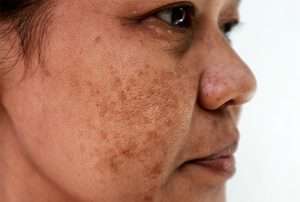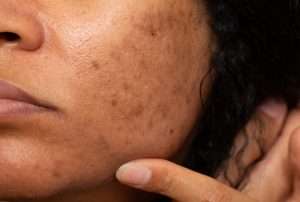Melasma: Causes, Symptoms And Prevention

Melasma
Melasma is a common skin condition that causes dark, discolored patches on the face. It is also known as chloasma or the “mask of pregnancy” as it often affects pregnant women. However, it can also affect men and women who are not pregnant.
Melasma occurs when the skin produces too much pigment, resulting in hyperpigmentation. The exact cause of melasma is unknown, but it is believed to be triggered by hormonal changes, sun exposure, and genetics.
The symptoms of melasma include dark patches on the face, particularly on the cheeks, forehead, nose, and upper lip. These patches may be tan, brown, or gray in color and have a distinct border. In some cases, melasma may also appear on other parts of the body that are frequently exposed to the sun.
Treatment options for melasma include topical creams, chemical peels, and laser therapy. However, melasma can be difficult to treat and may require multiple treatments over an extended period.
If you suspect that you have melasma, it is important to consult with a dermatologist for an accurate diagnosis and treatment plan. While melasma is a cosmetic concern, it can impact self-esteem and quality of life. With proper treatment, however, many people are able to achieve clearer, more even-toned skin.
Related Product – Serum for Melasma
Appearance Of Melasma
Melasma is a common skin condition that occurs mostly in women, characterized by dark, irregular patches on the face. These patches are usually brown or grayish in color and can appear on the cheeks, forehead, nose, upper lip, or chin. Melasma affects people with darker skin tones more often than those with fair skin, and it can be triggered by sun exposure, hormonal changes, or genetics.
To define melasma, it is a type of hyperpigmentation that occurs when the skin produces too much melanin, causing dark spots or patches on the face. The symptoms of melasma include dark patches on the face that can be either small or large, and they can be uneven in shape. Although melasma is not harmful, it can be distressing for people who are affected by it.
The causes of melasma are not entirely understood, but hormonal changes, such as during pregnancy or the use of birth control pills, can trigger it. Sun exposure is also a contributing factor as the UV rays can stimulate the production of melanin in the skin.
In conclusion, melasma is a skin condition that causes dark patches on the face, and it affects mostly women with darker skin tones. While it is not harmful, it can be distressing for those who experience it. Melasma treatment can help to reduce the appearance of dark patches on the skin, but it may take time to see significant improvement. If you notice melasma patches on your skin, it is essential to consult a dermatologist for diagnosis and treatment.
Occurance Of Melasma
Melasma is a common skin condition that causes dark, discolored patches on the skin. It occurs when the skin produces too much melanin, the pigment that gives skin its color. Melasma is most commonly seen on the face, specifically on the cheeks, forehead, nose, and upper lip. However, it can also occur on other areas of the body that are frequently exposed to the sun, such as the neck and forearms.
Melasma is more common in women than men, and it is often associated with hormonal changes, such as those that occur during pregnancy or while taking birth control pills. Sun exposure is also a major factor in the development of melasma, as UV rays can stimulate the production of melanin in the skin.
If you are experiencing symptoms of melasma, it is important to consult with a dermatologist to determine the best course of treatment for your individual needs. With the right treatment and proper sun protection, melasma can be effectively managed and controlled, allowing you to enjoy clear, even-toned skin.
Types Of Melasma
Melasma is a skin condition that has three different types based on the depth of the pigment:
Epidermal Melasma
Epidermal melasma is characterized by a dark brown color and a well-defined border. It appears obvious under black light and may respond well to treatment. This type of melasma is located in the top layer of skin (epidermis) and is caused by an increase in melanin production.
Dermal Melasma
Dermal melasma has a light brown or bluish color and a blurry border. It appears no differently under black light and doesn’t respond well to treatment. This type of melasma is located in the deeper layers of the skin (dermis) and is caused by the deposition of melanin in the dermal layer.
Mixed Melasma
Mixed melasma is the most common type of melasma and has both bluish and brown patches. It shows a mixed pattern under black light and shows some response to treatment. This type of melasma is a combination of both epidermal and dermal melasma, and therefore, can be difficult to treat.
Overall, understanding the type of melasma is important in determining the most effective treatment plan. A Wood’s lamp examination can be helpful in determining the depth of the pigment and guiding treatment decisions.
Causes Of Melasma
Melasma, characterized by dark patches on the face, is a common skin condition. Understanding melasma causes is crucial to managing this hyperpigmentation issue. Melasma occurs when there is an overproduction of melanin, the pigment responsible for skin color, resulting in dark spots on the face.
The primary trigger of melasma is excessive sun exposure. Ultraviolet (UV) rays stimulate melanocytes, the cells that produce melanin, leading to the development of melasma patches. Hormonal changes, especially during pregnancy or while taking birth control pills, can also contribute. These hormonal fluctuations can stimulate melanin production, causing melasma on the face.
Genetics play a role as well, with a family history of melasma increasing the likelihood of its development. Ethnicity and skin type are linked to melasma risk too. People with darker skin, such as those of Asian, African, or Hispanic descent, are more prone to melasma due to their higher melanin content.
Other factors include heat, certain cosmetics, and fragrances that can cause skin irritation, potentially triggering melasma. Furthermore, thyroid dysfunction and medications like anti-seizure drugs and photosensitizing medications can exacerbate melasma symptoms.
Understanding the underlying causes of melasma helps individuals take preventive measures. Sun protection through sunscreen and protective clothing, hormone regulation, and avoiding skin irritants are vital in managing and potentially reducing the appearance of melasma.
Related Article – The Best Serums For De Pigmentation
Symptoms Of Melasma
Understanding the symptoms of melasma is crucial for recognizing and managing this condition. Here’s what you need to know:
Distinctive Hyperpigmentation:
One of the primary symptoms of melasma is the appearance of dark spots or patches on the face. These patches are usually brown or grayish in color and can vary in size and shape.
Patch Patterns:
Melasma often presents itself in distinct patterns on the face, such as symmetric patches on the cheeks, forehead, and upper lip. This characteristic distribution helps in identifying the condition.
Triggered by Sun Exposure:
Melasma symptoms tend to worsen upon exposure to sunlight. Ultraviolet (UV) rays stimulate the production of melanin, exacerbating the hyperpigmentation on the affected areas.
Hormonal Influences:
Hormonal changes, such as pregnancy or the use of birth control pills, can trigger melasma. These hormonal shifts lead to an overproduction of melanin, contributing to the dark patches.
Genetic Predisposition:
Genetics also play a role in the development of melasma. If you have a family history of the condition, you might be more prone to experiencing its symptoms.
Aggravated by Heat:
Excessive heat can exacerbate melasma symptoms. Activities that cause facial sweating can lead to increased pigmentation in affected areas.
Chronic and Recurrent:
Melasma is often a chronic condition that can recur even after treatment. Understanding its symptoms can help individuals manage and address pigmentation issues effectively.
Recognizing the symptoms and underlying causes of melasma is the first step toward seeking appropriate treatment and skincare routines. Be sure to consult a dermatologist for an accurate diagnosis and personalized guidance.
Prevention Of Melasma
While treatment options exist to address melasma, prevention is often the best approach. Understanding the causes of melasma is crucial to taking proactive steps in keeping those dark patches at bay.
Melasma occurs due to various factors, including hormonal changes, sun exposure, genetics, and certain medications. Hormonal fluctuations, often triggered by pregnancy, birth control pills, or hormone therapy, can lead to the development of melasma. Protecting your skin from excessive sun exposure is another key factor in preventing melasma. UV rays can stimulate the production of melanin, resulting in hyperpigmentation. Wearing broad-spectrum sunscreen daily, seeking shade, and wearing protective clothing are essential measures.
Genetics can also play a role in melasma, so if you have a family history, taking preventive measures becomes even more important. Avoiding certain medications known to trigger melasma, like hormone replacement therapies, is advisable if you’re prone to this condition.
By understanding these causes and taking proactive steps, such as wearing sunscreen, using protective clothing, and being cautious about hormonal fluctuations and medications, you can significantly reduce the risk of developing melasma. Remember, prevention is key to maintaining a healthy, even-toned complexion and keeping those melasma dark patches at bay.
Products For Pigmented Skin
Are you struggling with facial pigmentation issues? No need to worry, because Plix Pineapple 3% Tranexamic Acid Serum is the perfect solution for you.
Specifically designed to combat pigmentation problems, this serum from Plix is an excellent addition to your skincare regimen.
The Plix Serum for Pigmentation is enriched with potent fruit-derived active ingredients that target pigmentation concerns on your facial skin. The star component, Tranexamic Acid, is highly effective in inhibiting the activation of melanin, thus reducing pigmentation and promoting clearer, more radiant skin. With consistent application, you can anticipate significant enhancements in the appearance of conditions like melasma, hyperpigmentation, and post-inflammatory erythema (PIE) scars.
Utilizing the natural benefits of pineapple extract, this Plix pineapple serum takes advantage of its brightening and exfoliating properties. The blend of Tranexamic Acid and pineapple extract results in a powerful formula that gently eliminates dead skin cells, revealing a refreshed and revitalized complexion.
Related Article – How to Choose the Right Serum for Pigmentation: A Step-by-Step Guide
Frequently Asked Questions (FAQs)
What is melasma and what causes it?
Melasma is a skin issue causing dark patches on the face due to excess melanin production. Hormonal changes, sun exposure, and genetics contribute to its cause.
Will Plix Pineapple Tranexamic Acid Serum remove dark spots from my skin?
Yes! The Pineapple 3% Tranexamic Acid Face Serum targets melasma, hyperpigmentation, and post-inflammatory erythema (PIE). It contains Tranexamic Acid, a proven ingredient that inhibits melanin production, effectively reducing dark spots on the skin.
What are melasma symptoms?
Melasma leads to brown or gray patches on the face, mainly cheeks, forehead, and upper lip. It doesn’t cause discomfort but affects self-esteem.
Is the Plix serum comedogenic & acnegenic?
No! The Pineapple 3% Tranexamic Acid Face Serum is uniquely formulated with fruit extracts and active ingredients, ensuring it doesn’t clog pores or lead to acne. Moreover, the serum is vegan, devoid of parabens, mineral oil, and synthetic fragrances. Its gentle, natural components make it suitable for sensitive or acne-prone skin.
Can melasma be prevented?
Regularly use high SPF sunscreen, wear protective clothing, manage hormones, and avoid excessive sun to reduce melasma risk.














